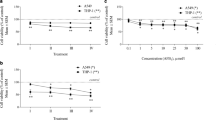Abstract
The ability of 9-day-old mycelia of Aspergillus parasiticus NRRL 2999 to degrade aflatoxin varied depending on the substrate used to grow the mold. Substrates which allowed substantial mycelial growth yielded mycelia which actively degraded aflatoxin. Substrates which allowed minimal growth of mycelia yielded mycelia with little ability to degrade aflatoxin. Biodegradation of aflatoxin was also strain-dependent. A. parasiticus NRRL 2999 and NRRL 3000 actively degraded aflatoxin, A. flavus NRRL 3353 was less active, and A. flavus NRRL 482 and A. parasiticus NRRL 3315 degraded minimal amounts of aflatoxins. Those aspergilli producing greatest amounts of aflatoxin also degraded aflatoxins most rapidly, whereas those strains which produced minimal amounts of aflatoxin generally degraded aflatoxins less effectively. Substrates which allowed maximum aflatoxin production also yielded mycelia which actively degraded aflatoxins, whereas media which allowed limited production of aflatoxin generally yielded mycelia with minimal ability to degrade the toxin. Although exceptions exist, generally as aflatoxin production increased so did the ability of mycelia to degrade the toxin.
Similar content being viewed by others
References
Davis, N. D., U. L. Diener & D. W. Eldridge. 1966. Production aflatoxin B1 and G1 by Aspergillus flavus in a semisynthetic medium. Appl. Microbiol. 14: 378–380.
Doyle, M. P. 1975. Thermal inactivation of Aspergillus flavus and Aspergillus parasiticus conidiospores subjected to various environmental conditions. M. S. thesis, University of Wisconsin-Madison, Madison, WI.
Doyle, M. P. & E. H. Marth. 1975. Thermal inactivation of conida from Aspergillus flavus and Aspergillus parasiticus. I. Effects of moist heat, age of conidia, and sporulation medium. J. Milk Food Technol. 38: 678–682.
Doyle, M. P. & E. H. Marth. 1978. Aflatoxin is degraded by fragmented and intact mycelia of toxigenic aspergilli grown 5 to 18 days with and without agitation. J. Food Prot. 41: (in press).
Gaddi, B. L. 1973. Mycotoxin-producing potential of fungi isolated from cheese. Ph.D. thesis, University of Wisconsin-Madison, Madison, WI.
Hesseltine, C. W., O. L. Shotwell, M. Smith, J. J. Ellis, E. Vandegraft & G. Shannon. 1968. Production of various aflatoxins by strains of the Aspergillus flavus series. pp. 202–210. In M. Herzberg (ed.) Proceedings of the first U.S.-Japan conference on toxic microorganisms. U. S. Government Printing Office, Washington, D. C.
Raper, K. B. & D. I. Fennell. 1965. The genus Aspergillus. William and Wilkens Co., Baltimore. p. 41.
Shih, C. N. & E. H. Marth. 1969. Improved procedures for measurement of aflatoxins with thin layer chromatography and fluorometry. J. Milk Food Technol. 32: 213–217.
Steel, R. G. D. & J. H. Torrie. 1960. Principles and procedures of statistics. McGraw-Hill Book Co., Inc., New York. pp. 161–169.
Author information
Authors and Affiliations
Rights and permissions
About this article
Cite this article
Doyle, M.P., Marth, E.H. Aflatoxin is degraded by mycelia from toxigenic and nontoxigenic strains of aspergilli grown on different substrates. Mycopathologia 63, 145–153 (1978). https://doi.org/10.1007/BF00490929
Issue Date:
DOI: https://doi.org/10.1007/BF00490929




